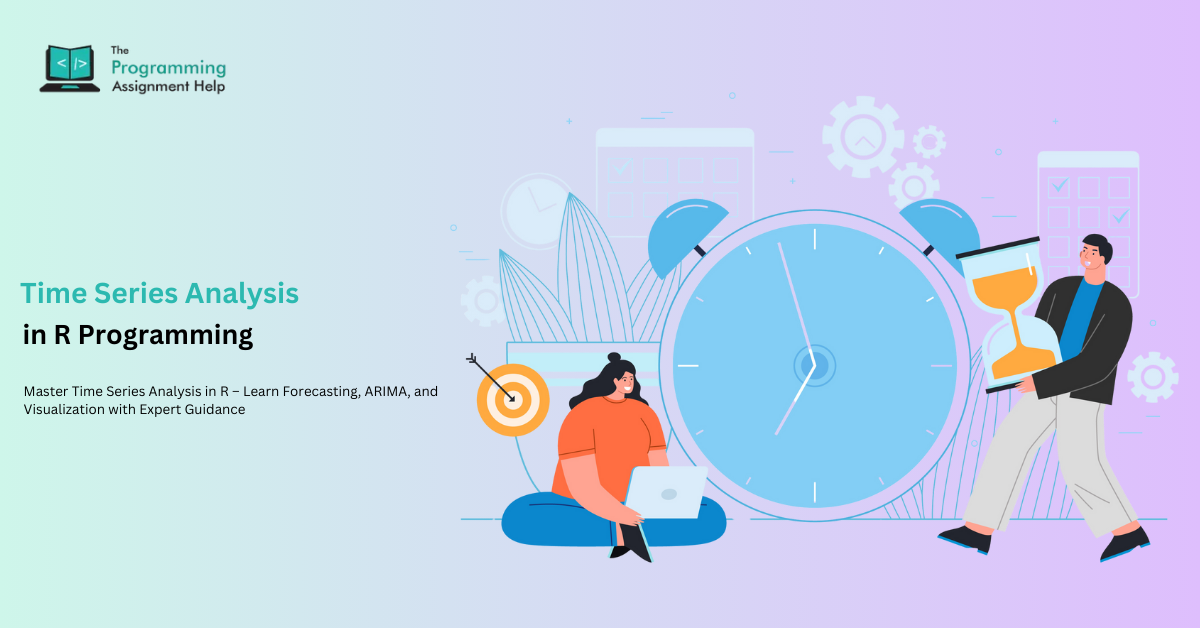
- 6th Sep 2025
- 00:11 am
- William
Time Series Analysis in R includes the study, modelling, and forecasting of time-varying data. It is often applied to various industries such as finance, economics, environmental science, among others. R has an extensive package and function ecosystem dedicated to time series analysis, which makes R popular in time series research and analysis.
Important Steps in Time Series Analysis with R:
- Data Exploration: Load time series data on R, examine features of time series data on trend, seasonality and pattern using visualization plot such as line graphs and seasonal decomposition.
- Time Series Decomposition: Decompose the data into trend, seasonality, and residuals using R package decompose() or forecast.
- Testing for Stationarity: Test whether the mean and variance of data are invariant over time, transform data as necessary, with tests such as adf.test() or kpss.test().
- Model Identification: Select an appropriate model like ARIMA, STL or ETS depending on the properties of the time series.
- Model Fitting: Using functions such as auto.arima () or ets () fit the selected model and test its quality by performing diagnostic tests and goodness-of-fit tests.
- Forecasting: Run forecasts using the functions forecast() and interpret these values visually using autoplot() to draw quick comparison with historical data.
- Model Evaluation: Evaluate forecast accuracy against actual values using measurements such as MAE, MSE or Error distribution analysis.
- Time Series Visualization: Design simple and engaging time series graphics in R with the help of such tools as ggplot2, dygraphs, and seasonal decomposition plots.
Popular R Time Series Analysis Packages:
R has a detailed package on time series analysis, which makes it easy to formulate and predict data modeling, which is why it is used more by analysts and researchers.
- 'forecast': Offers time series forecasting services such as automatic ARIMA modelling, ETS models, and numerous forecast evaluation measures.
- 'xts' and 'zoo': Provide specialised data structures for processing time series data, making manipulation and analysis easier.
- 'TSA': Uses time series analysis techniques such as ARIMA and seasonal decomposition.
- 'ggplot2' and 'dygraphs': This software is widely used to create visually beautiful and interactive time series plots.
Use cases of Time Series Analysis in R Programming
Time Series Analysis in R is used for a variety of purposes across industries and areas. Here are a few major scenarios in which R is regularly used for time series analysis:
- Financial Prediction: R is commonly used in finance to forecast the stock prices, currency rates, and market indices. Such models as ARIMA, GARCH assist the analyst in making choices, based on historical market data.
- Economic Indicators: R is utilized by economists to simulate and predict important indicators of economic growth, inflation, and unemployment, both tracking trends and economic cycles.
- Energy Consumption and Production: Energy intelligence practitioners use R to forecast energy use, enhance energy efficiencies, behavior, and impact of renewable energy sources.
- Healthcare and Epidemiology: R is applicable in healthcare planning because of the ability to predict patient raise, tracking the spread of disease, and assessing intervention outcomes.
- Climate and Environmental Science: Climate scientists will explore long-term trends with R in aspects of temperature, rain and sea levels, which helps in predicting the future of the environment.
- Sales and Demand Forecasting: R tools such as forecast and prophet enable businesses to predict the trend of sales and effective management of inventory and supply chain efficiency.
- Web and Social Media Analytics: In R, analysts could check activity visits, user statistics, and social media trends with their trends over the years to help craft marketing and engagement initiatives.
- Production and Quality Control: R helps the manufacturers to detect faults, trace production patterns and plan optimisation leaks in order to accomplish quality.
- Telecommunications: Telecom vendors use R to forecast network traffic, outage, and resource assignment to operate operations.
- Human Resources: R is used by HR departments to create staffing needs, identify performance patterns, and staff turnover in a bid to facilitate better workforce planning.
The time series analysis in R is flexible and analysts could gain insight into a time series data to aid in making reasonable decisions in many industries.
Step-by-step method to perform Time Series Analysis in R Programming
Time series analysis in R, involves the critical steps from data exploration to model evaluation. We'll use the built in ‘AirPassengers’ dataset here in a simple illustration.
-
Step 1: Load the necessary libraries and datasets
```
# Load required libraries
library(tidyverse)
library(forecast)
# Load the AirPassengers dataset
data("AirPassengers")
```
-
Step 2: Explore the Dataset
```
# View the first few rows of the dataset
head(AirPassengers)
# Check the structure of the dataset
str(AirPassengers)
# Plot the time series data
plot(AirPassengers, main = "Airline Passenger Counts Over Time", xlab = "Year", ylab = "Passenger Count")
```
-
Step 3: Time Series Decomposition
Check for stationarity using statistical tests. In this example, we'll use the Augmented Dickey-Fuller test.
```
# Decompose the time series
decomp_result <- decompose(AirPassengers)
# Plot the decomposition
plot(decomp_result)
```
-
Step 4: Stationarity Testing
Check for stationarity using statistical tests. In this example, we'll use the Augmented Dickey-Fuller test.
```
# Augmented Dickey-Fuller test for stationarity
adf_test <- adf.test(AirPassengers)
print(adf_test)
```
-
Step 5: Differencing (if needed)
If the time series is not stationary, apply differencing to make it stationary.
```
# Differencing to achieve stationarity
diff_series <- diff(AirPassengers)
# Plot differenced series
plot(diff_series, main = "Differenced Time Series", xlab = "Year", ylab = "Differenced Passenger Count")
```
-
Step 6: Model Identification and Fitting
Determine and find a suitable time series model (e.g., ARIMA) as per the attributes of the data and model fit the data.
```
# Automatic ARIMA model selection and fitting
arima_model <- auto.arima(AirPassengers)
print(arima_model)
```
-
Step 7: Model Diagnostics
Check the diagnostics of the fitted model to ensure its adequacy.
```
# Model diagnostics
checkresiduals(arima_model)
```
-
Step 8: Forecasting
Generate forecasts using the fitted model.
```
# Forecasting with the ARIMA model
forecast_result <- forecast(arima_model, h = 12) # Forecasting for the next 12 months
print(forecast_result)
# Plot the forecast
autoplot(forecast_result, main = "ARIMA Forecast for Airline Passenger Counts")
```
-
Step 9: Model Evaluation
Evaluate the accuracy of the forecast by comparing it to actual values.
```
# Calculate forecast accuracy metrics
accuracy(forecast_result)
```
These are the beginning of the time series analysis within R, and more methods like season adjustment, regression adjustment and multifaceted forecasting must be reachable to match different demands.
Conclusion
R is useful in time series analysis to identify trends, patterns, and foresee trends of any industry such as finance, healthcare, energy, and climate research. R offers rich packages, strong models and sophisticated visualization tools, which give the ability to model and make sure that decisions are made right. Either in business forecasting or research, learning to use these methods helps develop better analytical skills. Our R Programming Assignment Help and Machine Learning Assignment Help provides professional advice on effective, accurate and customized solutions to complex projects.








